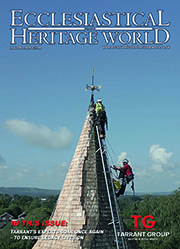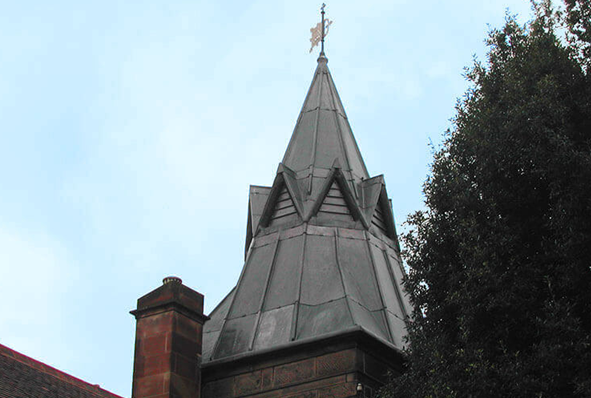Heritage Roofing
Heritage roofing - maintaining our iconic buildings
The UK is home to some of the most iconic buildings in the world, from stunning churches and cathedrals to historic stately homes. Each and every one of these remarkable feats of architecture requires regular maintenance to ensure they remain in the very best condition, allowing them to be enjoyed for generations.
Lightning Protection
When lightning strikes are you protected against this act of God?
The issue of lightning protection in churches is one that has exercised this publication for many years. In this four-part series of spotlights on the issue we will be revisiting various aspects of the subject, beginning with an overview of current thinking.
Traditional Lime
Lime: it’s better for buildings – and for the environment
It is now fairly well known that cement is not good for old buildings and that lime mortar should be used. But why? What are the advantages and what are the disadvantages? In order to begin to answer those questions it is necessary to understand the nature of traditional building, the process by which buildings used to be built, and how it differs from modern construction, the process by which we build today.
Audio Visual
Audio visual equipment in church buildings
This guidance is issued by the Church Buildings Council under section 55(1)(d) of the Dioceses, Mission and Pastoral Measure 2007. As it is statutory guidance, it must be considered with great care. The standards of good practice set out in the guidance should not be departed from unless the departure is justified by reasons that are spelled out clearly, logically and convincingly.
Read More...
CRE Events
Churches are coming under starter’s orders for CRE 25
Churches across the nation are beginning to make preparations for their visit to Christian Resources Exhibition’s CRE 25.
Insurance
You need to ensure that reasonable precautions are in place at your church to keep it safe for those who use it. To do this, you need to think about what might cause harm to people.
You will then need to decide if the precautions already in place are adequate. If they are not, you may need to identify further action to prevent any danger. When done formally, this is known as a risk assessment.
LPOW Grants
£23 million government package to support restoration of thousands of listed places of worship
Heritage Minister Sir Chris Bryant has announced that the Listed Places of Worship Grant Scheme will be extended into the next financial year, providing £23 million so that thousands of historical buildings, including churches, synagogues, mosques and temples, can carry out restoration work.
Lead Roofing
Lead is one of the oldest materials in the roofing industry and is still commonly used throughout the world today.
Lead roofing is a traditional roofing method which has been used in the industry for hundreds of years, and is therefore proven to be extremely reliable. Lead roofing, and sand-cast lead, in particular is ideal for old buildings such as churches or historical renovations, whereas milled lead roofing is a mass-produced alternative, used for precision and accuracy in homes and commercial buildings alike.
Home
WAKE-UP CALL TO HERITAGE CRIMES
Crimes and anti-social behaviour that damage England’s historic environment will for the first time be tackled in a much more coordinated way through a new initiative launched by English Heritage today (11th February 2011).
Under the strategic guidance of English Heritage, the Police (through the Association of Chief Police Officers (ACPO)) and the Crown Prosecution Service (CPS), a nationwide network is developing among enforcement bodies, local authorities, non-governmental organisations, professional groups and amenity societies to systematically tackle and reduce offences such as architectural theft, including metal theft, criminal damage, illegal metal detecting, graffiti, vehicle nuisance and arson.
Representatives from more than 40 organisations, ranging from The National Trust, The Church of England, Crime Stoppers and Ministry of Defence to National Parks, The Woodland Trust and The Historic Houses Association will be meeting for the first time on 11th February to discuss the formation of the Alliance to Reduce Crime against Heritage (ARCH). ARCH is a voluntary national network that will be used to take forward the initiatives and galvanise local action.
A memorandum of understanding to delineate responsibilities between the three strategic partners - English Heritage, ACPO and CPS - will be signed at the event. Local authorities will be encouraged to join the coordinated effort, with Canterbury City Council being the first authority also to have agreed to sign the memorandum.
Local history societies, amenity groups, neighbourhood watch and residents associations will be encouraged to raise awareness of the risk of criminal damage to historic sites and buildings in their area.
The model of Neighbourhood Policing, established to tackle the crime and day-to-day anti-social behaviours most affecting local neighbourhoods, provides a useful model for tackling heritage crimes. Local communities are urged to understand the heritage assets in their area that may be at risk of irreversible damage from crime and to report suspicious behaviours to their neighbourhood policing teams.
The profile and accountability of heritage crimes among police officers will also increase. For the first time, there will be a national lead in ACPO on heritage crimes and there will also be a dedicated portfolio holder in many police forces across the country.
Neighbourhood Policing and community involvement is expected to contribute considerably to improved intelligence and data on the ground, both of which are lacking at present.
The true extent of heritage crime is difficult to ascertain due to the way in which it is recorded and the fact it tends to be under-reported by victims. This initiative seeks to address the reluctance to report such crimes by increasing public awareness and placing the emphasis on a coordinated effort. The 2009 English Heritage study of illegal metal detecting suggested that the problem is growing and reported cases are only the tip of the iceberg. Metal theft from churches is also a serious issue, with the number of insurance claims in 2010 being twenty times as many as that in 2005.
In 2010 the first national assessment was conducted looking at existing information and disparate data that various organisations were able to supply, including: English Heritage’s Heritage At Risk Register; live known cases; geographical information on the spread and concentration of heritage assets; the 2009 study on illegal metal detecting; and, church metal theft data. This identified that arson, architectural theft (including metal theft), removal of artefacts from protected sites and vehicle nuisance pose the greatest threat.
Lincolnshire and the Peak District National Park, East of England, the South East, the and the South West and the Northumberland national parks have been identified as pilot areas because of the presence of many vulnerable historic sites and the enthusiasm of local partners.
In the next 12 months or so, the heritage crime initiative will focus on the prevention and detection of four broad types of crime:
- Damage caused to the historic environment – This refers to physical damage (as a result of fire, graffiti, vandalism and damage caused by cars, motorcycles and other means).
- Unlawful excavation and removal of articles from the historic environment – This refers to theft from scheduled monuments or protected wrecks and includes illegal metal detecting.
- Architectural theft – This refers to theft of items from historic buildings and structures like stone walls, vintage street signs and pavements. In recent years a new trend has emerged in the theft of lead and metal from roofs and guttering.
- Unlawful alteration and demolition of listed buildings
Baroness Andrews, Chair of English Heritage, said: “Heritage crime robs us of our history. Its effect on our lives is insidious and felt often too late. Beautiful buildings are scarred forever, places we treasure and enjoy lose their identity and appeal, evidence about our past is lost and tourism suffers, not to mention the burden on owners to repair and put things right. Society needs to work together to combat these criminal activities.”
Richard Crompton, Chief Constable of Lincolnshire and the ACPO national lead for heritage crimes, said: “This is a really important step which will have a significant impact upon the problem of crime and anti-social behaviour in and around our historic environment. A great many people care deeply about this sort of crime and I believe that we can tap into that concern and interest and work with communities to make a real difference.”
Nick Hunt Director of Strategy and Policy at the Crown Prosecution Service, said: "I was very pleased that English Heritage invited the Crown Prosecution Service to become a party to this memorandum. It should lead to much better working between English Heritage and its different partners including the CPS. We view heritage crime seriously and those who commit such crime should be aware that the CPS will prosecute if there is sufficient evidence for a realistic prospect of conviction and it is in the public interest."
Chief Inspector Mark Harrison, seconded from Kent Police in March 2010 to act as Policing Advisor for English Heritage to improve heritage crime prevention and law enforcement in England, said: “Good progress has been made in establishing coordinated working relations between the enforcement agencies and setting priorities at a national level, but the most important part of the initiative is the engagement of communities across the country in establishing their own local networks. A real difference will only follow if this galvanises local action.”




















